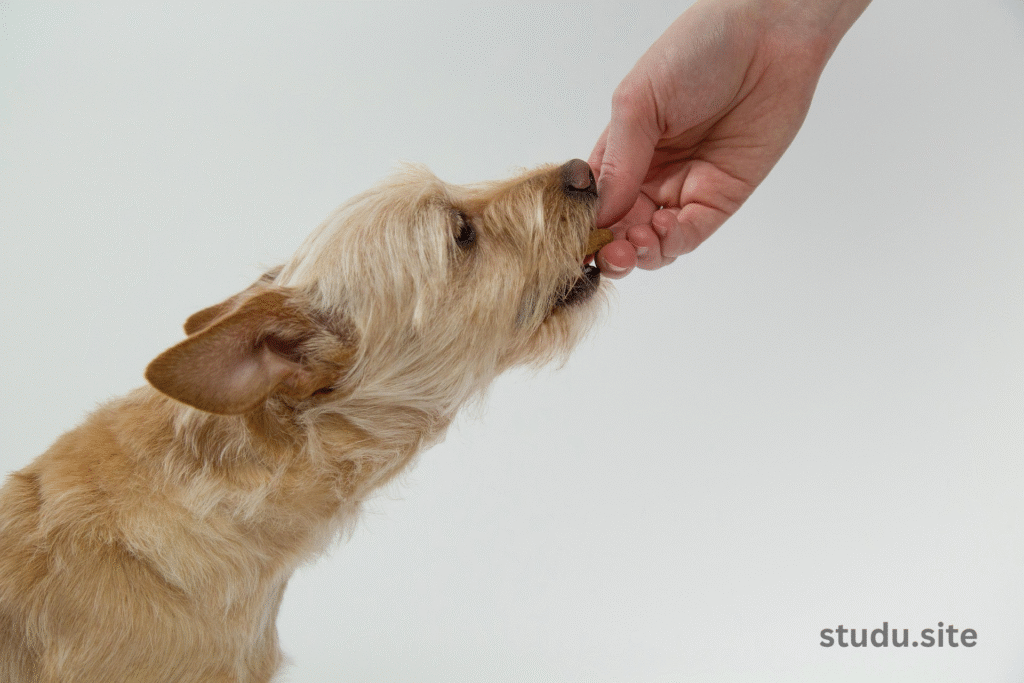Introduction
As a dog owner, you’ve probably caught your pup eyeing a slice of bread on the counter or wondered, “Can dogs eat bread?” Bread is a staple in many households, and it’s tempting to share a bite with your furry friend. While some types of bread can be safe for dogs in moderation, others pose health risks. Understanding which breads are dog-friendly, how to feed them safely, and what to avoid is crucial for your pet’s well-being. In this 2025 guide, we’ll explore the ins and outs of dogs and bread, covering safe options, potential dangers, and tips to keep your pup healthy.

Can Dogs Eat Bread?
Short answer: Yes, dogs may eat some kinds of bread in moderation, but it’s not a nutritional requirement. Bread contributes very little in the way of essential nutrients for dogs, which do well on a quality diet of protein, fats, and certain vitamins. But plain, fully baked bread is a possible safe occasional indulgence for many dogs if it is free of poisonous ingredients and given in moderation.
Let’s dissect the facts to know when and how bread may be included in your dog’s diet.
Healthy Types of Bread for Dogs
Not all breads are equal when it comes to consumption by dogs. Below are some types of bread that are safely consumed by dogs:
-
White Bread: Simple white bread, not containing added sugars, spices, or preservatives, is fine in moderation. It’s easily digestible but has little nutritional value.
-
Whole Wheat Bread: Whole grain or whole wheat bread is okay if your dog is not allergic to wheat. It has slightly more fiber, but excess is not good for the digestive system.
-
Sourdough Bread: Sourdough is okay in very small amounts if fully baked and not containing toxic additives. The sour taste may not be accepted by every dog.
-
Homemade Bread: Homemade bread with easy ingredients (flour, water, yeast, salt) is usually the best bet since you have control over what enters it.
When presenting bread to eat, make sure it’s plain, fully baked, and cut into small pieces to avoid any choking or gastrointestinal problems. Always look at the ingredients list for dangerous additives.
Breads to Avoid for Dogs
Though there are some safe breads, there are others that can be hazardous because of toxic ingredients or health hazards. Stay away from these:
-
Bread with Raisins or Grapes: Raisins, which exist in breads such as cinnamon raisin bread, are extremely poisonous to dogs and lead to kidney failure. Small quantities are just as risky.
-
Garlic or Onion Bread: Onions and garlic, which are typical of seasoned breads, are poisonous to canines, causing red blood cell damage and anemia.
-
Sweet Breads with Xylitol: Sweetened xylitol breads using an artificial sweetener are highly toxic, triggering a sudden release of insulin and life-threatening hypoglycemia.
-
Nut Breads: Bread products involving nuts such as walnuts or macadamia nuts can be toxic or cause obstruction of the intestines.
-
Raw Bread Dough: Raw dough can swell in the stomach of a dog and result in bloating or alcohol poisoning due to yeast fermentation.
Always read packaging or inquire about ingredients before sharing bakery or restaurant bread.
Health Benefits of Bread for Dogs
In moderation, safe bread can provide minimal benefits, but it’s not an essential component of a dog’s diet:
-
Rapid Energy Supply: The carbohydrates in bread produce a rapid energy supply, so it can be a convenient snack for working dogs.
-
Digestive Aid: Whole grain breads have fiber, which can aid digestion when given in moderation.
-
Calming Snack: Plain bread serves as a calming snack for dogs with sensitive stomachs, but veterinary consultation is necessary for diet adjustment.
These benefits notwithstanding, bread must never be a substitute for a well-balanced canine food diet designed for canine nutritional requirements.
Risks of Feeding Bread to Dogs
Although safe breads are fine in moderation, there are some risks to beware of:
1. Digestive Problems
Bread is rich in carbohydrates, which can irritate a dog’s stomach if consumed excessively. Excessive bread intake can cause bloating, gas, or diarrhea, particularly in those with sensitive stomachs or grain intolerance.
2. Weight Gain
Bread is high in calories and low in nutrients and is thus easily gained by dogs when fed frequently. This can cause a dog to become obese, which may result in joint problems, diabetes, and heart disease.
3. Allergic Reactions
Dogs are allergic to wheat or gluten, found in most breads. Symptoms include itching, ear infections, or stomach upset. See your vet if you think a grain allergy is present.
4. Choking Hazard
Big pieces of bread, particularly crusty ones, may be a choking hazard or lead to intestinal obstructions. Always crumble bread into tiny, bite-sized morsels.
5. Toxic Ingredients
As noted, raisin breads, garlic bread, onion bread, xylitol breads, and nuts are poisonous. Even a little can lead to serious health problems that need to be seen by a vet immediately.
How Much Bread Can Dogs Eat?
It is all about moderation when it comes to feeding bread to dogs. As a treat, bread can not exceed 10% of your dog’s daily calorie allowance. To illustrate:
-
Small Dogs (10–20 lbs): A tiny bite (approximately 1–2 teaspoons) once or twice weekly.
-
Medium Dogs (20–50 lbs): A wee slice (1–2 tablespoons) sporadically.
-
Large Dogs (50+ lbs): A thin slice or several tiny pieces weekly.
Always keep a close eye on your dog following the addition of bread to observe any negative reactions. Discuss individual feeding recommendations with your veterinarian, particularly for dogs with health issues.
What to Do If Your Dog Ate Unsafe Bread
If your dog ingests bread with harmful ingredients or raw dough, move quickly:
-
Identify the Ingredients: Read the ingredients or packaging of the bread to verify whether it includes raisins, garlic, onions, xylitol, or nuts.
-
Contact Your Vet: Call your veterinarian or an emergency clinic immediately, even if your dog seems fine. Provide details about the bread and quantity eaten.
-
Monitor Symptoms: Watch for signs of distress, such as vomiting, lethargy, diarrhea, tremors, or difficulty breathing, and report them to your vet.
-
Collect Evidence: If possible, save a sample of the bread for your vet to identify harmful components.
Timely action may avoid severe complications from poisonous ingredients or fermentation of dough.
Tips for Safe Feeding of Bread to Dogs
To make bread a safe snack for your dog, use these tips:
-
Select Plain Bread: Use plain white bread or whole wheat bread without seasonings, sweeteners, or poisonous additives.
-
Cook Through: Never give raw dough because it can lead to life-threatening problems.
-
Serve Moderately: Restrict bread as an occasional treat to prevent weight gain or gastrointestinal issues.
-
Monitor for Allergies: Gradually introduce bread while monitoring for signs of sensitivity to wheat or gluten.
-
Avoid Human Preparation: Bread used in human food usually has butter, oils, or spices toxic to dogs. Prepare a plain portion separately.
FAQs Regarding Dogs and Bread
1. Can dogs be given bread daily?
No, bread is a special occasion food, not an everyday food. It is devoid of proper nutrients and can cause weight gain or digestive problems.
2. Is bread harmful to dogs with grain allergies?
Yes, wheat- or gluten-allergic dogs should not eat bread. Talk to your vet about grain-free treats.
3. Does my dog eat banana bread?
Banana bread usually has sugar, nuts, or xylitol in it, which is dangerous. Only give plain, unsweetened banana bread in small quantities.
4. What do I do if my dog has ingested raisin bread?
Call your veterinarian right away, as raisins are poisonous and lead to kidney failure. Act fast.
Conclusion
Therefore, can dogs eat bread? Yes, in moderation, plain bread such as white or whole wheat is safe every now and then as a treat for most dogs. But breads that contain poisonous ingredients such as raisins, garlic, onions, or xylitol should be avoided, and raw dough is especially hazardous. Although bread provides minimal advantages such as rapid energy or fiber, it’s far from being a powerhouse nutritionally for dogs and should never be substituted with a balanced meal. By selecting safe breads, feeding in moderation, and watching for reactions, you can responsibly share this treat.
Always ask your vet first to introduce new foods, particularly for dogs with allergies or medical conditions. For additional pet nutrition advice or to learn about other dog-friendly foods, consult your vet or your reliable pet care sources. Make your pup happy, healthy, and wagging their tail in 2025!
